|
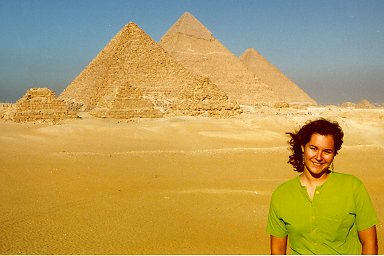 Incredible shot in front of all nine Pyramids without all
the tourists. The Great Pyramid, right-most pyramid, built by Khufu,
covers an area of 13 acres. Its original height of 146 meters has now become 137 meters
after the erosion of its summit. It consists of nearly 2.5 million blocks of limestone
ranging in weight from 2.5 tons to 15 tons. The Second Pyramid, center, was built by
Khafre. Although smaller than the Great Pyramid, it seems equally tall and imposing due to
its fortunate site higher on the plateau. Part of this pyramid still bears traces of the
outer limestone casing that once covered all of the Pyramids. The Third Pyramid of Menkaure is smaller in size
than its predecessors and never finished. Its height is 62 meters. It is distinguished by
the fact that the lower parts of its sides still retain their granite slab coverings. The
six smaller pyramids in the picture are the so-called Queens' pyramids. Incredible shot in front of all nine Pyramids without all
the tourists. The Great Pyramid, right-most pyramid, built by Khufu,
covers an area of 13 acres. Its original height of 146 meters has now become 137 meters
after the erosion of its summit. It consists of nearly 2.5 million blocks of limestone
ranging in weight from 2.5 tons to 15 tons. The Second Pyramid, center, was built by
Khafre. Although smaller than the Great Pyramid, it seems equally tall and imposing due to
its fortunate site higher on the plateau. Part of this pyramid still bears traces of the
outer limestone casing that once covered all of the Pyramids. The Third Pyramid of Menkaure is smaller in size
than its predecessors and never finished. Its height is 62 meters. It is distinguished by
the fact that the lower parts of its sides still retain their granite slab coverings. The
six smaller pyramids in the picture are the so-called Queens' pyramids. |
|
|
|
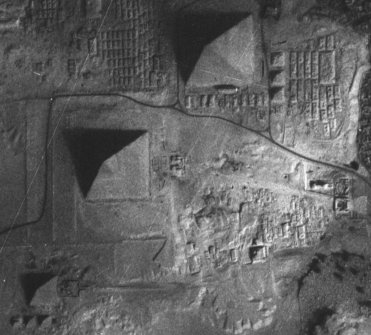 Aerial view of the Giza Plateau purchased
from terraserver. The topmost pyramid is
Khufu's Great Pyramid. Just to the right of his pyramid are his smaller Queens' pyramids
and up against the southern edge of the pyramid is the Solar Boat Museum. The middle
pyramid is Khafre's pyramid. Directly east of Khafre's pyramid is the Great Sphinx facing
East. In front of the Sphinx stands its temple with Khafre's valley temple just to the
right. The causeway leading from Khafre's pyramid to his valley temple
is clearly visible in this picture. In the lower left of this picture stands the third
pyramid of Menkaure with its three Queens'
pyramids. The rectangular structures to the left of the Great Pyramid are
mastabas of
the 4th and 5th Dynasties. Compare this picture to the "land version" one above. Aerial view of the Giza Plateau purchased
from terraserver. The topmost pyramid is
Khufu's Great Pyramid. Just to the right of his pyramid are his smaller Queens' pyramids
and up against the southern edge of the pyramid is the Solar Boat Museum. The middle
pyramid is Khafre's pyramid. Directly east of Khafre's pyramid is the Great Sphinx facing
East. In front of the Sphinx stands its temple with Khafre's valley temple just to the
right. The causeway leading from Khafre's pyramid to his valley temple
is clearly visible in this picture. In the lower left of this picture stands the third
pyramid of Menkaure with its three Queens'
pyramids. The rectangular structures to the left of the Great Pyramid are
mastabas of
the 4th and 5th Dynasties. Compare this picture to the "land version" one above. |
|
|
|
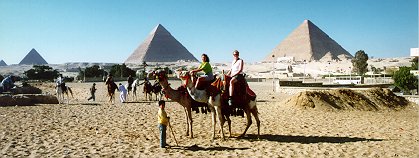 Scott and Grisel
touring the Giza Plateau on camels. The pyramids, from left to right, belong to Menkaure,
Khafre, and Khufu. The smaller queens pyramids can been seen to the left of Menkaure's
pyramid and to the right of the Great Pyramid. This picture was taken from the South-East. Scott and Grisel
touring the Giza Plateau on camels. The pyramids, from left to right, belong to Menkaure,
Khafre, and Khufu. The smaller queens pyramids can been seen to the left of Menkaure's
pyramid and to the right of the Great Pyramid. This picture was taken from the South-East. |
|
|
|
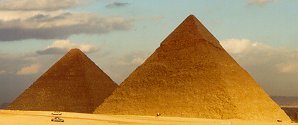 Khufu's (left)
and Khafre's (right) pyramids as seen from the west. The Great Pyramid is one of the
Seven Wonders of the Ancient World and
the only one that survived to modern times. Khufu's (left)
and Khafre's (right) pyramids as seen from the west. The Great Pyramid is one of the
Seven Wonders of the Ancient World and
the only one that survived to modern times. |
|
|
|
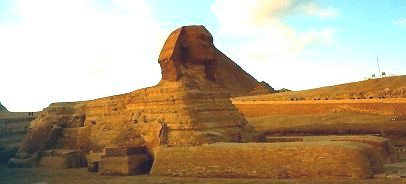 One of the most famous monuments in the whole world, the
Great Sphinx
at Giza, probably represents the 4th-Dynasty ruler, Khafre, although it has been argued
that it may represent his predecessor, Djedefra. Measuring 20 meters in height and 73
meters long, it was carved from a knoll of rock left behind after quarrying. One of the most famous monuments in the whole world, the
Great Sphinx
at Giza, probably represents the 4th-Dynasty ruler, Khafre, although it has been argued
that it may represent his predecessor, Djedefra. Measuring 20 meters in height and 73
meters long, it was carved from a knoll of rock left behind after quarrying. |
|
|
|
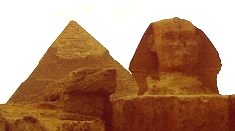 The
Great Sphinx and Khafre's Pyramid as seen from the East. The
Sphinx has been much battered by wind and sand erosion. It did not, contrary to popular
belief, lose its nose because of target practice at the time of the French invasion in
1798 -- the nose and its royal ritual beard had vanished long before then. The face had
been damaged by religious fanatics in 1380. Part of the beard was found between the paws
of the Sphinx in 1818 and is now in the British Museum. The
Great Sphinx and Khafre's Pyramid as seen from the East. The
Sphinx has been much battered by wind and sand erosion. It did not, contrary to popular
belief, lose its nose because of target practice at the time of the French invasion in
1798 -- the nose and its royal ritual beard had vanished long before then. The face had
been damaged by religious fanatics in 1380. Part of the beard was found between the paws
of the Sphinx in 1818 and is now in the British Museum.
|
|
|
|
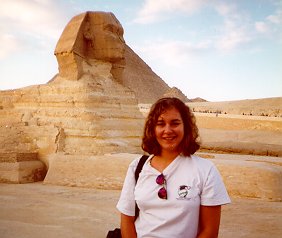 The Sphinx and a very tired Grisel (two
hours of sleep in a 48 hour interval is just NOT enough...) The Sphinx and a very tired Grisel (two
hours of sleep in a 48 hour interval is just NOT enough...) |
|
|
|
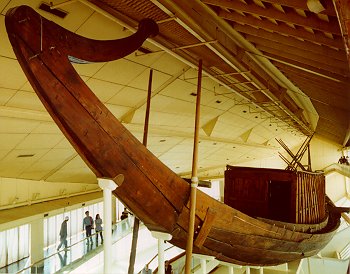 The Solar Bark, discovered in the pyramid
complex of Khufu at Giza, was reconstructed in situ from 1224 pieces. The cedar
ship is 141 feet long. It was likely intended to serve as a means of conveying the pharaoh
through the netherworld. The Solar Bark, discovered in the pyramid
complex of Khufu at Giza, was reconstructed in situ from 1224 pieces. The cedar
ship is 141 feet long. It was likely intended to serve as a means of conveying the pharaoh
through the netherworld. |
|
|
|
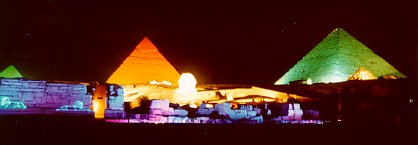 The Sound and
Light Show at Giza. The Sound and
Light Show at Giza. |

![]()
![]()
 Aerial view of the Giza Plateau purchased
from
Aerial view of the Giza Plateau purchased
from  Scott and Grisel
touring the Giza Plateau on camels. The pyramids, from left to right, belong to Menkaure,
Khafre, and Khufu. The smaller queens pyramids can been seen to the left of Menkaure's
pyramid and to the right of the Great Pyramid. This picture was taken from the South-East.
Scott and Grisel
touring the Giza Plateau on camels. The pyramids, from left to right, belong to Menkaure,
Khafre, and Khufu. The smaller queens pyramids can been seen to the left of Menkaure's
pyramid and to the right of the Great Pyramid. This picture was taken from the South-East. Khufu's (left)
and Khafre's (right) pyramids as seen from the west. The Great Pyramid is one of the
Khufu's (left)
and Khafre's (right) pyramids as seen from the west. The Great Pyramid is one of the
 The
The
 The Sphinx and a very tired Grisel (two
hours of sleep in a 48 hour interval is just NOT enough...)
The Sphinx and a very tired Grisel (two
hours of sleep in a 48 hour interval is just NOT enough...) The Solar Bark, discovered in the pyramid
complex of Khufu at Giza, was reconstructed in situ from 1224 pieces. The cedar
ship is 141 feet long. It was likely intended to serve as a means of conveying the pharaoh
through the netherworld.
The Solar Bark, discovered in the pyramid
complex of Khufu at Giza, was reconstructed in situ from 1224 pieces. The cedar
ship is 141 feet long. It was likely intended to serve as a means of conveying the pharaoh
through the netherworld. The Sound and
Light Show at Giza.
The Sound and
Light Show at Giza.